Electric Vehicles (EVs)
How will Australia manage the EV transition as the UK and Japan make their move?
Japan recently joined the growing ranks of countries that are set to move towards a ban on petrol and diesel-powered new cars, emphasising the need to shift towards a new generation of fuel technology.
With the framework for a transition by the middle of the next decade looking set to be a priority for the Japanese government, it is clear that Japan is ramping up its efforts to achieve a goal of being net carbon neutral by 2050. This means the sale of new cars with internal combustion engines could be at an end by the mid-2030s.
As mentioned above, Japan is merely one of a number of countries making the switch.
European lawmakers have been on the frontline in terms of making changes. And those changes are only coming up quicker, as countries accelerate efforts to meet net zero goals. In the UK, the sales ban on new petrol and diesel-powered cars is now targeting 2030 as opposed to the original timeline of 2035.

How might this impact new cars in Australia?
By now, and after a federal election where a green mandate has been given, you’re probably either chastising our politicians for not following suit, or alternatively, you might be wondering what does this all have to do with Australia?
The ramifications for motorists down under are more complex than you might believe. The UK and Japan are the largest markets in the world for right-hand-drive vehicles. Even Singapore, another right-hand-drive market, has pencilled in a 2040 deadline for the transition away from the internal combustion engine.
While the local government has yet to make any significant inroads as far as incentivising drivers to take up cars powered by electric or hybrid means – in fact, some state governments have introduced road user charges that are hardly helping the cause – this absence is quite stark when compared to overseas markets where motorists have a number of incentives and the infrastructure in place to consider buying a vehicle powered by ‘green’ energy. And of course, EV prices are far more affordable overseas. Uptake is picking up quickly in a number of international markets, with the building blocks in place to encourage drivers to make the switch, and pioneers like Tesla changing the game.
With Australia no longer in the picture as a car manufacturer, nor is it ever likely to be one in the future given the prohibitive costs associated with the industry down under, the prospect of the world leaving Australia behind shouldn’t be ignored.
Not only could Australia be left behind as other countries transition to more efficient and technologically sophisticated vehicles, but the cost of supplying Australia with right-hand-drive vehicles could increase as economies of scale begin to dissipate if not evaporate for car manufacturers. If this happens, you better believe that those companies will be passing on the costs to local motorists in the form of higher prices – as if manufacturers haven’t been increasing prices a number of times over the last couple years already.
New Cars and Software Updates

How would you react if you had to pay for the apps that appear on the touchscreen of your new car? Various auto manufacturers are looking at new ways to charge owners money for features that were previously sold as an option for the car when you bought it new. One idea that has shown up in their brainstorming sessions was to charge car owners subscription fees for features like Apple CarPlay and its phone-pairing connectivity – as BMW is already doing. Of course, this has been a feature that has been included for free on many mainstream cars.
Perhaps not so surprising to many would be the results that Cox Automotive collected, which were collected from a survey that asked a relatively small group of a little over 200 people about their thoughts and attitudes towards having to pay over and over again for features that used to be included at the point of sale. Around 75% of the survey respondents would refuse to pay for features on an ongoing basis.
When asked about having to pay for any safety features on an ongoing basis, the survey showed that around 80% would not want to pay for these safety items again and again. However, if forced to, these same respondents would be prepared to pay up to $35 per month. I’m not sure whether the people surveyed were by enlarge high-flyers or a decent cross-section of society that included your average wage earner. This cost per month was the highest level that these respondents would be prepared to pay for them if they were forced to.
A full 92% of respondents said that the physical items like heated and cooled seats, massage functions, or a refrigerated drinks box should be purchased as a one-off-at-the-point-of-sale option, just like anyone does now when they buy a new car with extra options.
A new car these days is full of computerised technology, so any software updates or subscription fees for software enhancements, EV power upgrades, satellite or vehicle locator enhancements need to be paid for somewhere along the line. The funny thing is that, even as with a standard Office update on a desktop, the real-life software updates rarely have any significant practical benefits in real-life usage for the user. Sometimes a new desktop Office update can even complicate things with the user having to relearn the fifth new visual format and appearance update in two years – I know, I was probably exaggerating.
I guess I would be prepared to pay for a driving range enhancement or a better battery capacity after purchasing a new EV, though I guess this could be a bargaining carrot for keeping a customer longer and loyal to a brand, or even enticing them to buy a certain car in the first place.
Interestingly, around 50% of the survey respondents weren’t even aware that subscription fees for car features were a prerequisite. Rising costs that grow quicker than someone’s usable income is never a welcome scenario, so these sorts of surveys and results will hopefully provide auto manufacturers with the necessary feedback from their customers, and on the customers’ tolerance for any new additional fees in general.
Reasonably Priced Hybrid Vehicles (MG to Z)
In-between stages can sometimes get tricky. The next set of sit-ups before truly hitting your peak fitness regime. That gap year before study, or the six months prior to the new job contract starting. What about the EV world? We’re not capable of running a full fleet of EV cars yet, but maybe there’s an in-between vehicle that ticks all the right boxes before we go fully electric.
The truth is that the new hybrid vehicles are the best cars for this moment in time. They deliver the very best low fuel consumption figures and will also try to run pure electric as much of the time as is practical or possible.
Hybrids are great vehicles, usually well-priced, thus perfect for softening the blow to the wallet – there are some hideously expensive EVs available. Most desirable new EVs have price tags that, for most of us, will be well beyond our budget. So what hybrid vehicles are on the market for reasonable money? How much will they set you back when you buy new? And what sort of fuel consumption can you expect? Let’s have a look and see (MG to Toyota)…
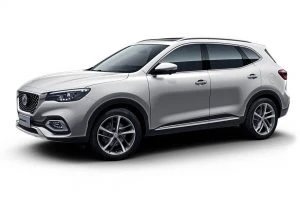
MG HS Plus EV SUV
Yes, a new and very fuel efficient Hybrid for less than $50k is possible, thanks to the snazzy MG HS Plus EV SUV. Nice to drive, comfortable, and with roomy interiors, loaded with technology, and five-star safe, these are a great hybrid buy. The MG HS Essence-spec plug-in hybrid joined the range in 2021 and uses a 119 kW/250 Nm 1.5-litre Turbo four driving the front wheels through a 7-speed dual-clutch gearbox. It boasts a strong presence among class leaders that include the Toyota RAV4, Mazda CX-5 and Nissan X-Trail. It comes with 5-star safety technology that includes autonomous emergency braking with pedestrian avoidance and satellite navigation as standard. MG says it takes about 7 seconds for the 0-100 dash, while returning a fuel efficiency that can be as low as 1.7 litres/100 km or more commonly up to 5.7 litres/100 km.

MINI Countryman Cooper SE Classic SUV
The Countryman Cooper SE Classic is a cute three-cylinder plug-in hybrid with electrically-assisted AWD. BMW indicates a combined cycle as low as 2.4 litres/100 km but may look more like 4.5 litres/100 km for most of the time. Combining a 1.5-litre Turbo 3-cylinder ULP petrol (100 kW/220 Nm) and a 7.6 kWh lithium-ion plug-in battery, this combined system equates to an output of 165 kW of power and 385 Nm of torque. The small MINI sees off the 0-100kmh sprint in 6.8 seconds and is a lot of fun to drive. The MINI Countryman’s roomy interior is backed up by 450 litres of luggage space behind the back seats, growing to 1275 litres if the seats are folded down.

Mitsubishi Eclipse Cross PHEV ES
From around $51k you can get one of these new. The 2022 Mitsubishi Eclipse Cross PHEV ES is a very stylish small SUV with very low running costs. Aspire and Exceed models are also available. Comfortable and loaded with tech and safety, the Mitsubishi Eclipse Cross PHEV makes a lot of sense. Even the top of the range Exceed with all of the bells and whistles can be bought for under $60k. Mitsubishi indicates as low as 1.9 litres/100 km is possible, though real world figure of 3.7–4.0 litres/ 100 km is still impressively low in the real world. Boot space is around 350 litres, and 0-100 km/h takes about 10.5 seconds.

Peugeot 3008 GT Sport Plug-in Hybrid AWD SUV
For less than $90k you can have one of these very stylish hybrids. Boasting a 1.6-litre Turbo ULP engine and electric power that combines to a maximum of 222 kW, this sporty SUV uses an 8-speed automatic. Thanks to twin electric motors driven by a 13.2 kWh lithium-ion battery pack, the Peugeot 3008 PHEV enables zero-emissions driving for up to 60km. Its 222 kW power output and a 6.5-second 0-100 km/h acceleration time makes this one of the fastest SUVs in its class. It is also 4×4 capable, making it a highly desirable vehicle for undertaking light off-road terrain. Gorgeous full-grain Nappa leather-appointed seats with grey stitching, nicely-integrated twin digital screens (a 10.0-inch central touch-screen with satellite navigation and a 12.3-inch driver display), real world fuel efficiency likely be around 5–5.5 litres/100 km (but much less than this is possible), and you have yourself quite a vehicle. Peugeot reckons the 3008 PHEV can achieve a combined fuel consumption figure of 1.6 litres/100 km with CO2 emissions of 36.4g/km. Boot space is 395 litres.
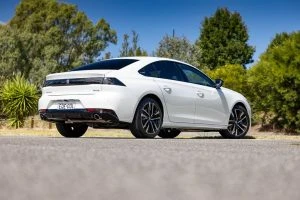
Peugeot 508 GT Plug-in Hybrid
From around $84k one of these extremely stylish cars can be yours. Its petrol-electric hybrid powertrain allows the svelte sedan to drive up to 55 km (WLTP) in silence, by switching off the combustion engine and using only its electric motor. It’s hard not to be impressed with the car’s looks and style. Inside, the leather seats, the dashboard design, the sporty cockpit layout, and the sheer attention to detail is very impressive. A 12.3-inch iCockpit digital driver’s display, a 10.0-inch central touch-screen, a 10-speaker sound system, dual-zone automatic climate control, five-star safety, it’s all there! 0-100 km/h takes around 8.2 seconds, while the Plug-in Hybrid system uses a 1.6-litre turbo-petrol four-cylinder engine developing 133 kW at 6000 rpm and 300 Nm at 3000 rpm to get the job done. The official combined-cycle fuel consumption figure is 1.8 litres/ 100 km, but to achieve that would require frequent charging – something that’s not always possible in the real world. Expect around 5.0 to 6.5 litres/100 km combined. Boot space is 487 litres.
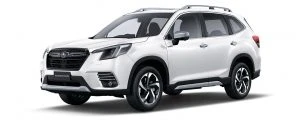
Subaru Forester Hybrid

Subaru XV Hybrid
The fifth generation of Subaru’s mid-size, all-AWD Forester SUV was updated in late 2021 with a new look, plus refinements to steering and suspension and a revised instrument panel. The smaller XV Hatch also uses similar tech. Expect around 6-7 litres/100 km for the 2.0-litre boxer-based mild hybrid powerplants. Off-road is no problems at all for the Forester or XV and safety is off the top shelf. All Foresters and XV Hybrids get active cruise control, blind-spot monitors, lane-change assist, “active” LED headlights and rear cross traffic alert. The Forester offers truly generous passenger space and luggage capacity (422 litres expanding to 1768 litres with rear seats folded). The XV has 340 litres behind the rear seats. Both are nice to drive adventure seekers.
Toyota Hybrids
Almost every model on the Toyota showroom floor can be a hybrid. There are so many that I’ll list them all here in picture form.

Toyota C-HR Hybrid SUV from $42k.

Toyota Camry Hybrid Sedan between $38-52k.

Toyota Corolla Hatch and Sedan between $32-40k.

Toyota Kluger SUV between $60-83k.
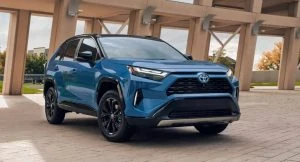
Toyota RAV4 Hybrid

Toyota Prius between $43-51k.
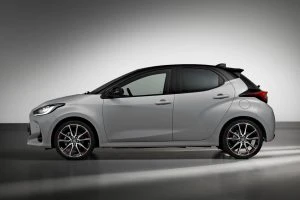
Toyota Yaris Hybrid
These are truly excellent hybrid vehicles, and, if you don’t know where to start, Toyota is a great place. Reliability, practicality, some of the best hybrid economy figures (usually very achievable: 3.5 to 5.5 litres/100 km), and excellent 5-star safety are all reasons why Toyota Hybrids are so good. They are also very competitively priced right across the board from the little Yaris Hatch to the larger Camry Sedan or Kluger SUV. Get ready to be impressed.
Be an in-betweener and gain some of the Hybrid benefits.
Reasonably Priced Hybrid Vehicles (Kia-Merc)
 In-between stages can sometimes get tricky. The next set of sit-ups before truly hitting your peak fitness regime. That gap year before study, or the six months prior to the new job contract starting. What about the EV world? We’re not capable of running a full fleet of EV cars yet, but maybe there’s an in-between vehicle that ticks all the right boxes before we go fully electric.
In-between stages can sometimes get tricky. The next set of sit-ups before truly hitting your peak fitness regime. That gap year before study, or the six months prior to the new job contract starting. What about the EV world? We’re not capable of running a full fleet of EV cars yet, but maybe there’s an in-between vehicle that ticks all the right boxes before we go fully electric.
The truth is that the new hybrid vehicles are the best cars for this moment in time. They deliver the very best low fuel consumption figures and will also try to run pure electric as much of the time as is practical or possible.
Hybrids are great vehicles, usually well-priced, thus perfect for softening the blow to the wallet – there are some hideously expensive EVs available. Most desirable new EVs have price tags that, for most of us, will be well beyond our budget. So what hybrid vehicles are on the market for reasonable money? How much will they set you back when you buy new? And what sort of fuel consumption can you expect? Let’s have a look and see (Kia-Merc)…

Kia Niro Hybrid S
The Kia Niro comes in regular hybrid, plug-in PHEV hybrid, and also pure electric (EV) form. Hybrid variants of this small SUV use a 77 kW/147 Nm 1.6-litre ULP engine that is mated to a 44.5 kW electric motor. The PHEV version can run in EV mode for around 58 km, while the pure EV model has a 150 kW/395 Nm motor and a 455 km WLTP (World harmonised Light vehicle Testing Procedure) range. All variants are available in regular or Sport form – the Sport model adding more technology and luxury such as Apple CarPlay/Android Auto, climate control and part-leather seat trim, as well as extra safety in the form of blind spot monitoring, rear parking sensors and rear cross traffic alert. Drive away in one of these from around $45k. Boot space is 382 litres for the regular hybrid, while the PHEV drops to 324 litres.
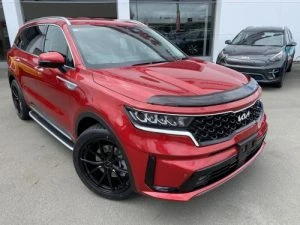
Kia Sorento HEV GT-Line and PHEV GT-Line
Drive away from in a HEV Sorento for around $73k or a PHEV Sorento for around $88k. Being a spacious SUV, the Sorento is a very practical companion for the family. The HEV model runs with a 1.6 litre Turbo engine and an electric motor that puts out a healthy combine output of 169kW. The 6-speed auto is smooth and well-mapped. Expect a combined fuel consumption of around 5.5 litres/100 km. In PHEV form, the Sorento has 195 kW, Kia indicating a combined fuel consumption of 1.6 litres/100 km is possible, though it will likely be more than this in a real world commute. The 7-seat Kia Sorento SUV won the 2021 car sales Best Family SUV award. Festooned with sensors, cameras and digital screens, it can even park itself without anyone inside. Autonomous emergency braking, adaptive cruise control, blind-spot monitoring and rear cross-traffic collision avoidance are all standard. The roomy cabin is enhanced by a boot that has over 600 litres, and when all-seats are folded, a whopping 2000 litres is possible.

Lexus ES 300h
One of the most luxurious hybrid sedans you can buy – let alone hybrid vehicles on the market – for under $70k new for the Luxury version or $90k new for the Sports Luxury version, this stylish car can be yours. Toyota indicate that a combined city/highway run can be as low as 4.8 litres/100 km. A combined 160 kW of power and five-star safety, what more could you want? Boot space is 454 litres, and the 0-100 km/h takes around 8.5 seconds.

Lexus UX 250h SUV
The company’s first EV, the UX 300e has a 150 kW/300 Nm FWD electric powertrain and a 54.3 kW/h battery pack, the Lexus UX 300e claims a 360 km range. But it is the Lexus UX 250h SUV Hybrid with the 2.0-litre 131 kW ULP regular hybrid engine that we’re particularly interested in here, which is available in Luxury, Crafted Edition, Sports Luxury and F Sport guise. The Luxury Lexus UX 250h version can be had for well under $60k, a very reasonably-priced luxury machine all things considered. These are five-star safe, FWD, extremely reliable, and very comfortable to drive. Toyota indicate around 4.5 litres/100 km for a combined highway/city cycle for hybrid versions. Boot space is 438 litres.

Mercedes Benz A250e Sedan and Hatch
Immensely low running costs can be had for this plug-in hybrid. If everything suits the PHEV commute, then Mercedes Benz indicates you could see as low as 1.6 litres/100 km on a combined cycle. Luxurious, safe, and fun to drive, these can be had for under $80k. A 1.3-litre Turbo ULP engine with a plug-in hybrid combo that produces 160 kW max through its smooth 8-speed automatic FWD system. The 2022 A-Class A250e runs the 0-100 km/h dash in less than 7 seconds, providing well for passengers and their luggage, driving with the poise and comfort that are hallmarks of the brand. Safety, quality, comfort, and premium equipment levels are all up to expected Mercedes Benz standards. Boot space is 315 litres for the Sedan and 310 litres for the Hatch.
Be an in-betweener and gain some of the benefits.